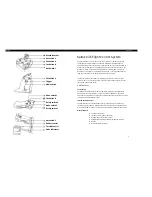
The counter begins counting when it is armed. The arm usually occurs between edges on the
Gate input. You can select whether to read the first active low or active high semi-period using
the
CI.SemiPeriod.StartingEdge
property in NI-DAQmx.
The following figure shows an example of an implicit buffered semi-period measurement.
Figure 59. Implicit Buffered Semi-Period Measurement
1
2
3
1
3
3
SOURCE
GATE
Counter Value
Buffer
1
3
2
2
1
1
1
3
1
2
0
Counter
Armed
Starting
Edge
For information about connecting counter signals, refer to the
section.
Pulse versus Semi-Period Measurements
In hardware, pulse measurement and semi-period are the same measurement. Both measure the
high and low times of a pulse. The functional difference between the two measurements is
how the data is returned. In a semi-period measurement, each high or low time is considered
one point of data and returned in units of seconds or ticks. In a pulse measurement, each pair
of high and low times is considered one point of data and returned as a paired sample in units
of frequency and duty cycle, high and low time or high and low ticks. When reading data, 10
points in a semi-period measurement will get an array of five high times and five low times.
When you read 10 points in a pulse measurement, you get an array of 10 pairs of high and low
times.
Also, pulse measurements support sample clock timing while semi-period measurements do
not.
Frequency Measurement
You can use the counters to measure frequency in several different ways. Refer to the
following sections for information about cRIO controller frequency measurement options:
•
Low Frequency with One Counter
•
High Frequency with Two Counters
•
Large Range of Frequencies with Two Counters
•
Sample Clocked Buffered Frequency Measurement
For more information about choosing the best frequency measurement option, refer to the
Choosing a Method for Measuring Frequency
84
|
ni.com
|
cRIO-904x User Manual
















































